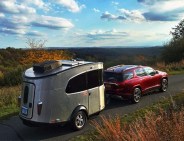
Airstream’s signature teardrop shape dates back to 1929 when Wally Byam built the first Airstream trailer. It began as a tent built atop a Model T chassis, which was soon replaced by the recognizable aerodynamic permanent shelter. It’s come a long way since then — Airstream has plenty of hefty models for a life on the road. But it’s getting back to the basics with its aerodynamic, ultra-light, superbly technical, teeny yet beautiful, Basecamp. We chatted with Airstream CEO Bob Wheeler to get all the details on how they managed to pack a working home inside this petite riveted trailer — complete with that epic panoramic window view.
7 photos
Inside Airstream’s Jackson Center, Ohio factory Photos by Airstream
Q: Airstream has such iconic design roots. How does that influence making a new product? How much do you look to the past?
A: Given the weight of our history, we have to make a concerted effort to honor our past without allowing ourselves to be bound by it. And really, the Basecamp is the perfect example of this design philosophy. It uses some of our trademark elements, like aluminum and rivets, but sets aside the iconic “silver bullet” shape in favor of something smaller, sleeker, and more aggressive. And here’s a little “inside baseball”: as a further nod to our heritage, it’s based loosely on the 1935 Torpedo, an Airstream design that actually pre-dates the current silver trailer style. Not many people know that.
Q: Can you tell us about the aerodynamic shape — is it purely for fuel efficiency? Or is it in part your brand identity?
A: It’s really a little of both. Every Airstream is designed with aerodynamics in mind, a kind of “form follows function” approach that dictates a lot of what we do. With Basecamp, it was really about marrying that iconic, Airstream design with a trailer that was small enough and light enough to be pulled by many SUVs.













